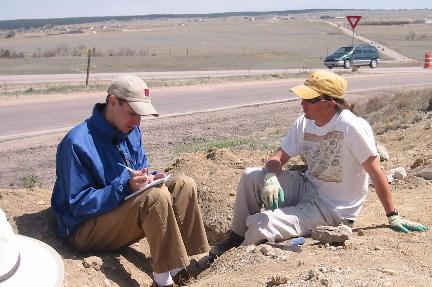


Reporter from The Gazette (Colorado Springs) interviews Rich Barclay (DMNS), 4/22/03.
|
The Denver Museum
of Nature & Science (DMNS) & its "Fossil
Posse" are working on another fossil plant locality as part of the
Denver Basin Project. This site, termed "Chopping at the Gap",
is east of Colorado Springs. It is believed to be in the D1 strata
of the Denver Basin - beginning approx. 68 MYA and ending about 64 MYA
(million years ago).
The D1 & D2 sections are separated by the paleosol layer (a brightly-colored interval marking an unconformity in the stratigraphic record. The red, orange & sometimes purple paleosol consists of mudrocks that show morphologic features indicating ancient soil development [2]. This paleosol layer has yet to be found near "Chopping at the Gap". However, it's believed to be somewhere between the quarry (foreground at left) and the line of pine trees (background at left) at the Black Forest. The pine trees prefer the soil mix of the D2 layer because of its looser, more coarse material and better drainage. The fossil layer at "Chopping at the Gap" is approximately 0.5 meters thick. It's believed to be a crevasse-splay (see "Meandering River") because of its mat layer of horizontal leaves at the bottom and mix of fine sandstone & imperfect horizontal leaves just above the mat. Until further excavation is done at this site, its exact locality cannot be revealed. The property belongs to El Paso County. The roadcut is an El Paso County Dept of Transportation right-of-way. There is no public access at this site. The image at left shows large seeds, believed to be from the walnut family, found at the quarry.
|
|
Note: This locality has been designated as DMNS #2687. |
||
1.
The
"Fossil Posse" is a group of staff and volunteers at the Denver
Museum of Nature & Science (DMNS) specifically organized to respond
rapidly to fossil discoveries. For more on the Fossil Posse, CLICK
HERE.
2.
"The stratigraphic and climatic significance of Paleogene alluvial paleosols
in synorogenic strata of the Denver Basin, Colorado.", Timothy M. Farnham
and Mary J. Kraus, 2002.
Hosting donated by Wagner Database Solutions, Inc. |